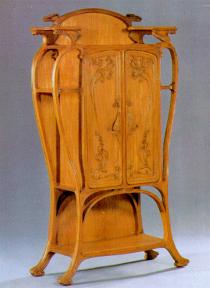
A fruitwood salon cabinet by EugèneGaillard
c.1901-02; ht 72in/184cm; value code A/B
FURNITURE
THE PARIS SCHOOL

A fruitwood salon cabinet by EugèneGaillard
c.1901-02; ht 72in/184cm; value code A/B
1. Is the form sculptural but relatively restrained?
2. Is the piece simmetrical?
3. Is it curvaceous, or does it contain a curved element?
4. Is it made of fruitwood?
5. Does any carving involve whiplash motifs in low relief?
6. Is the piece free of applied marquetry decoration?
7. If a chair, is any upholstery sympathetic to the form?
The Paris School
The two centres of French Art Nouveau design were Paris and Nancy. The designers of the
so-called Paris School were associated with the Parisian publisher and dealer, Siegfried
Bing (1838-1905), and his Pavillon de I'Art Nouveau at the Paris Exhibition of
l900. Bing sponsored several designers, such as Georges de Feure (1868-1928), Eugène
Gaillard (active 1895-1911), Erdward Colonna (b.1862) and the architect Hector Guimard
(1867-1942), who designed some striking entrances with organic motifs for the Paris Metro.
| Forms The Paris designers achieved a balance between elegant forms and strong organic elements, especially slender, sinuous stems or whiplash-type carving. Eugène Gaillard's large fruitwood salon cabinet, shown in the main picture, incorporates strongly curved, plant-like elements. The symmetrical form is typical of the Paris School. * Gaillard produced bedroom and dining suites for the Paris Exhibirion. * Some of Gaillard's pieces include metal inlay. Paris School designs rend to be traditional and restrained. However, many
pieces incorporate both traditional and innovative elements, as does the chair, above,
with its elongated back. Paris School chairs rarely include stretchers, but slender
cabriole-type feet are fairly common. Here, carved decoration is limited to the edges,
with a whiplash motif at the top of the seat rail. |
Hector Guimard's furniture is more sculptural than that of other Paris designers, and he often made clay maquettes which were translated into wood. As with the pearwood chair, above, Guimard's designs of 1900-10 were more gently curved and more sparsely decorated than his earlier work. He often used dark mahogany.
Georges de Feure's furniture tends to be either ornate or, like the cherrywood chair, above,
remarkably restrained. Typical features include stylized floral and organic carved motifs,
and simple white cotton upholstery, although he also often used embroidered silk or
damask. He often highlighted his furniture wich lacquerwork or gilt, and used pale woods
in decorative combination with veneered figured panels. |